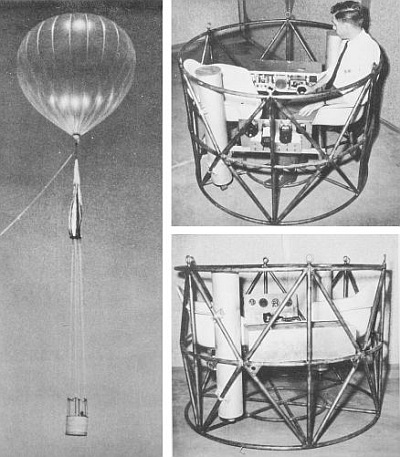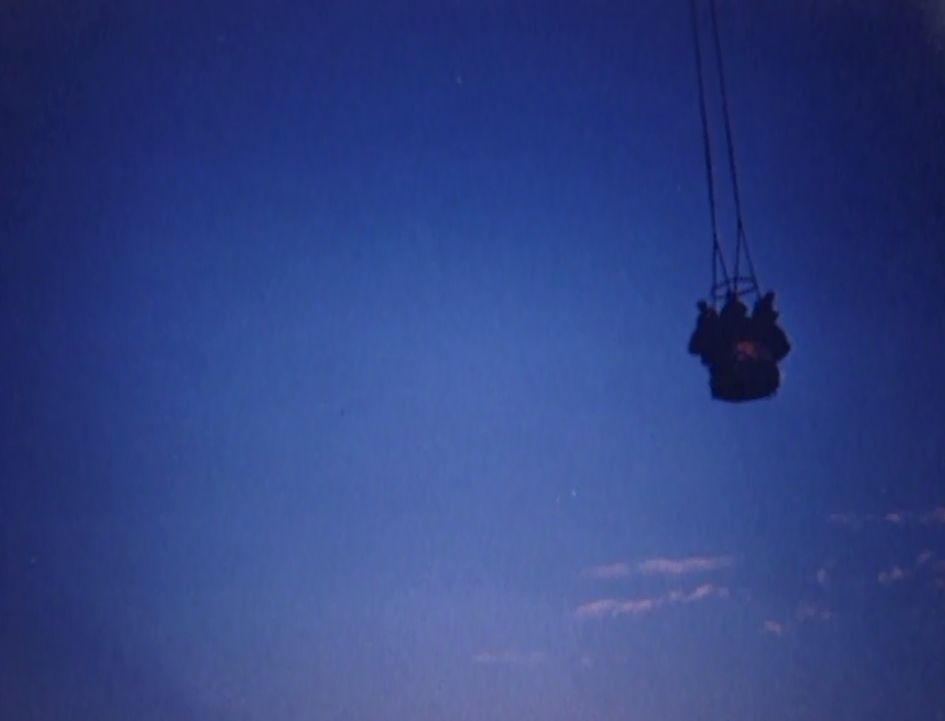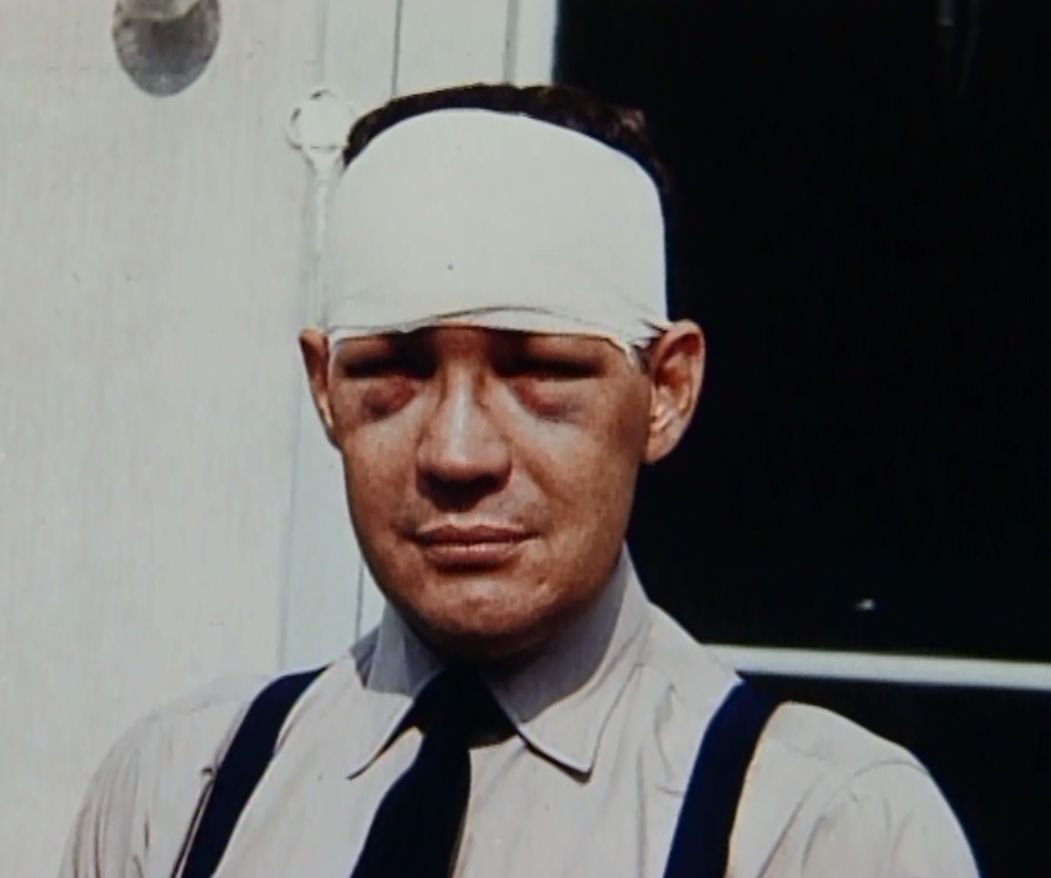Purpose of the flight and payload description
The SKY-CAR system was a special gondola developed during 1956 by Otto Winzen to support low-altitude scientific research and ballooning instruction. The Sky-Car comprised a cylindrical frame gondola made from steel tubing suspended from a polyethylene balloon. Depending on the desired altitude, balloon size varied from 31.5 feet (13,500 cubic-foot capacity) to 39.34 feet (27,000 cubic-foot capacity). The balloon train included a 40.4-foot diameter parachute like the one being used for the Manhigh capsule as a backup in case the balloon malfunctioned.
The gondola had seats for two people, but had enough room to accommodate a third person. It was 56 inches in diameter and 40 inches tall. For flight, a canvas cover was laced around its exterior and it had a plywood floor. Onboard instrumentation included an altimeter, a rate of climb indicator, 8-Day Aircraft Clock with Sweep Second Hand, magnetic compass, drift meter and controls for Balloon cutaway.
The radio gear was packaged separately in a box that could be dumped overboard as ballast if necessary. For shipping, the balloon, parachute, and other necessary equipment could be packed into the gondola.
During the development of the MANHIGH manned program, Sky-Car was used by pilots and candidates to earn their Civil Aeronautics Agency balloonist's license. To earn a lighter-than-air Pilot's Certificate, a candidate had to complete six instructional flights of not less than two hours' duration, one controlled flight to an altitude of 10,000 feet, and a solo flight lasting at least an hour.
Although they were at relatively low altitudes, flights in the Sky-Car posed a certain element of risk.
Details of the balloon flight
Balloon launched on: 5/21/1959 at 2:41 local
Launch site: Holloman Air Force Base, Alamogordo, New Mexico, US
Balloon launched by: Balloon Branch, Holloman Air Force Base (HAFB)
Balloon manufacturer/size/composition: Zero Pressure Balloon
End of flight (L for landing time, W for last contact, otherwise termination time): 5/21/1959 at amanecer/sunrise
Balloon flight duration (F: time at float only, otherwise total flight time in d:days / h:hours or m:minutes - ): 4 h
Landing site: 10 miles NW of Roswell, New Mexico, US
The objetive of the flight was to exercise gas valving and ballasting techniques necessary for balloon control and to practice landings. The pilots were Capt. Joseph W. Kittinger, Capt. Dan. D. Fulgham and capt. William Kaufman. The SKY-CAR flights were launched by the Holloman AFB Balloon Branch. To satisfy safety requirements, the flights were closely monitored by medical personnel at all times. A helicopter with medical personnel followed the flights during daylight hours, a C-131 aircraft followed during hours of darkness, and at all times medical personnel followed in an ambulance. Balloon recovery and communications technicians also followed the missions on the ground in a communications vehicle and a balloon recovery vehicle. The safety requirements were a result of several recent balloon mishaps that resulted in serious injuries to the pilots.
The training flight -the second in the series- was launched at 2:41 a.m. on May 21, 1959, from behind the Balloon Branch building, Bldg. 850 at Holloman AFB. Just after sunrise on May 21, 1959, following a successful low level training flight east of Holloman AFB over the Sacramento Mountains, Kittinger, the instructor pilot, determined the balloon should be landed in a small field approximately 10 miles northwest of Roswell. This was necessary because of approaching bad weather and the field was the last suitable landing site before overflying the city of Roswell. When the balloon touched down, a higher than normal forward velocity for landing caused the gondola to overturn. The three pilots, were spilled from the gondola pinning Fulgham's head between the edge of the gondola and the ground. The impact shattered his helmet and he sustained a head injury. When the three pilots climbed out from under the gondola, Fulgham noticed that his "...head seemed to be protruding outward from underneath [his] helmet...". Kittinger also received an injury, a minor facial laceration. The crew of the nearby chase helicopter and personnel in the ground tracking vehicles rushed to the scene. For medical treatment, the pilots were transported by the helicopter to nearby Walker AFB.
When the helicopter landed at Walker AFB, it was met by armed security personnel who sought to verify the purpose of the unannounced arrival. The security personnel escorted the balloon pilots to the hospital.
Fulgham's nose was barely visible on his swollen face, his eyes swelled shut and black, his skin turned yellowish. A bandage wrapping his head created the image of the classic science-fiction alien which was always associated with the myth of Roswell and which could be the origin of one of the many "reports" of witnesses who say they have seen supposed alien bodies at the military facility.
External references
- Touching Space: The history of the project MANHIGH a Book wich offers the most comprehensive history of the project by Gregory Kennedy
- The Roswell Report: Case Closed James McAndrews, Headquarters United States Air Force, 1997
907If you consider this website interesting or useful, you can help me to keep it up and running with a small donation to cover the operational costs. Just the equivalent of the price of a cup of coffee helps a lot.






